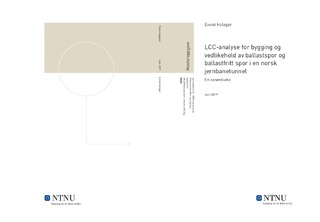| dc.description.abstract | Ballastspor er den tradisjonelle måten å bygge jernbanespor på i Norge. Med større trafikkbelastning og høyere hastigheter har denne konstruksjonen vist seg å ha begrenset motstand mot degradering, altså nedknusning. Dette gir økende vedlikeholdsbehov, og dermed økende kostnader. På grunn av dette ser man etter alternativer som kan løse disse utfordringene på en god måte.
I flere andre land i verden ser man en alternativ måte å bygge jernbanespor på, nemlig ballastfritt spor. Dette er en konstruksjon hvor ballasten er erstattet med en armert betongplate, som gjør at man unngår utfordringene man møter ved ballast. Man møter imidlertid et sett andre utfordringer med det ballastfrie sporet. Den utfordringen som får størst fokus er kostnaden. Man har fra utlandet erfart at ballastfritt spor koster mer å bygge enn ballastspor. Undersøkelser som tidligere er gjennomført i Norge viser at kostnaden kan være opp mot det dobbelte.
I denne studien er kostnadene som påløper for et ballastfritt spor og et ballastspor med samme lengde, over en periode på 60 år, blitt analysert. Ved å benytte diskontering er nåverdien for livsløpskostnaden for de to alternativene beregnet. Med gitte avgrensninger og datagrunnlag viser resultatene en neglisjerbar forskjell i kostnaden for ballastspor og ballastfritt spor over 60 år. Dette må imidlertid ses i sammenheng med de store usikkerhetene knyttet til datagrunnlaget som er brukt i analysen, og det konkluderes i denne studien med at man på bakgrunn av dette ikke kan si at ballastfritt spor er et mindre kostbart alternativ enn ballastspor, men heller ikke mer kostbart.
Noe av det som er veldig interessant er at trenden som kommer frem i analysen ligner veldig på det man ser i tilsvarende analyser i andre land. Dette betyr at det trolig vil være mulig å oppnå besparelser slik man har fått i disse landene. I datagrunnlaget som er brukt er byggekostnaden for ballastfritt spor 77% høyere enn for ballastspor. Allikevel vil de ha den samme livsløpskostnaden over 60 år på grunn av ballastsporets høye vedlikeholdskostnad, som er over dobbelt så stor som for det ballastfrie sporet.
Avslutningsvis diskuterer denne studien den praktiske betydningen av tallene fra analysen. Det er trolig for tidlig å ta beslutninger ut ifra en slik analyse for en norsk situasjon, siden grunnlagsdataene enda er for usikre. Studien har allikevel avdekket flere forslag til videre arbeid som kan gi informasjon og data som på en bedre måte kan gjengi det virkelige bildet, og være med på å vurdere om det vil være fordelaktig å bygge ballastfritt spor i Norge. | |
| dc.description.abstract | Ballasted track is the traditional way of building railway lines in Norway. Greater traffic loads and higher speeds have revealed a limited resistance to degradation, which is the action taking place when the ballast material is being crushed. With increasingly maintenance needs, and thus increasing maintenance costs, one looks for alternatives that can handle these challenges in a good way.
Several other countries in the world, build railway track in an alternative way, called ballastless track or slab track. Ballastless track is a construction where the ballast bed is replaced by a reinforced concrete slab. Here the challenges encountered in ballasted tracks are simply no longer present. However, there are other challenges with the ballastless track, where the main one is the cost. Ballastless track have a higher construction cost than the ballasted track, and earlier studies carried out in Norway show that the cost can be twice as high.
In this study, the costs incurred for a ballastless track and a ballasted track of the same length have been analyzed over a period of 60 years and the lifetime costs are calculated. Using discounting, the present value of the two options is calculated, and with the available data, the results over the 60-year analysis period show a negligible difference in the cost of a ballasted track and a ballastless track. However, this must be seen in the light of the great uncertainties in the data. On the basis of this analysis it cannot be said that ballastless track is a less expensive alternative than ballasted tracks, but neither that it is more costly.
One very interesting result of this analysis is that the trend that emerges is very similar to what one sees in similar analyses in other countries. They have experienced lower costs for ballastless track. The similar trends suggest we may achieve similar savings in Norway. In the data basis used, the construction cost for the ballastless track is 77% higher than for the ballasted track, but nevertheless they will have the same life-cycle cost over 60 years. This is due to the high maintenance cost of the ballasted track, which is over twice as large as the ballastless track.
This study finally discusses the practical significance of the analysis. It is probably too early to carry out a precise analysis for the Norwegian case, since the basic data is too uncertain. This study nevertheless gives several proposals for further work that can provide information and data that better reflect the real picture and help assess whether ballastless track can be advantageous in Norway. | |
